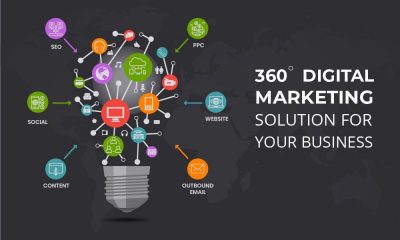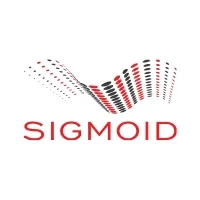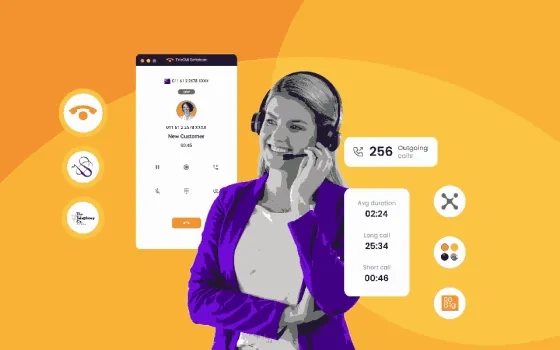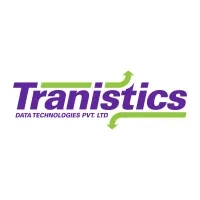Could you please tell us how easy it is to access the Internet today because the number of people who access the Internet every day is still increasing?
That’s right. In fact, according to Pew Research, “constant” internet use among adults has increased by 5% over the last three years. And, as we often say, the way people shop and buy has really changed with it-that is, offline marketing isn’t as effective as it used to be.
Marketing has always aimed to connect with the viewer in the right place, at the right time. Today, that means that they need to meet them where they are already spending their time, the internet.
Introducing Digital Marketing-In other words, any form of marketing exists online.
Let us talk a lot about inbound marketing as a really effective way to engage, engage, and delight customers online. However, many people around the world have asked many questions about digital marketing. So we decided to answer them. Click on the links below to jump to each question or see how digital marketing is done today.
So how do you define today’s digital marketing?
What is digital marketing?
Digital marketing includes any marketing activity that uses electronic devices or the Internet. Businesses connect with current and future customers through digital channels such as search engines, social media, email, and other websites.
Experienced inbound marketers may say that inbound marketing and digital marketing are essentially the same things, but there are some minor differences. In conversations with marketers and business owners in the US, UK, Asia, Australia, and New Zealand, we learned a lot about how these small differences are observed around the world.
What is the role of digital marketing for a company?
Traditional marketing can be in print advertising, telephone communications, or psychological marketing, while digital marketing can be done electronically and online. This means the brand has endless possibilities, including email, video, social media, or website-based marketing opportunities.
At this stage, digital marketing is essential for business and brand awareness. It seems that all other brands have websites. If not, you have at least a social media presence and digital advertising strategy. Because digital content and marketing are so common, consumers are now expecting and relying on how to learn about brands.
In short, to be competitive as a business owner, you need to embrace some aspects of digital marketing.
There are so many options and strategies associated with digital marketing that you can be creative and experiment with different marketing strategies within your budget. Digital marketing can also use tools such as Google analytic dashboards to monitor campaign success and ROI over traditional promotional content such as billboards & print ads.

Digital Marketing Services
How do companies define digital marketing?
Digital marketing is defined by using numerous digital tactics and channels to connect with customers who spend a lot of time online. From the website itself to online branding assets for your business (digital advertising, email marketing, online brochures, etc.), there are a variety of tactics within the scope of “digital marketing.”
The best digital marketers have a clear understanding of how each digital marketing campaign supports their overarching goals. And, depending on the goals of your marketing strategy, marketers can support larger campaigns through free, paid channels.
For example, a content marketer can create a series of blog posts that generate leads from a new ebook recently created by a business. The company’s social media marketers may help promote these blog posts through paid and organic posts on the social media accounts of the business. Perhaps an email marketer creates an ebook campaign to send company details to the person who downloaded the ebook. More on these specific digital marketers later.
Types of Digital Marketing
Search Engine Optimization (SEO)
Content Marketing
Social Media Marketing
Pay Per Click (PPC)
Affiliate Marketing
Native Advertising
Marketing Automation
Email Marketing
Online PR
Inbound Marketing
Sponsored Content
Below is an overview of some of the most popular digital marketing strategies and the channels associated with each.
Search engine optimization (SEO)
This is the process of optimizing your website to “rank” higher in search engine results pages, which increases the amount of organic (or free) traffic you receive.
There are many ways to approach SEO to generate qualifying traffic to your website. These include:
ON Page SEO:
This type of SEO focuses on all content that is “on the page” when you visit a website. By exploring your search volume and purpose (or meaning) keywords, you can answer questions to your readers and rank them higher on the search engine results page (SERP) they generate.
Off Page SEO:
“Off-Page SEO” refers to any activity that you or others do away from your website to increase the ranking of your page on search engines. Many people associate out-of-page SEO with link building, but it goes beyond that.
Technical SEO:
This type of SEO focuses on the back end of your website and how you code your pages. Image compression, structured data, and CSS file optimization are all forms of technical SEO that can speed up website loading. This is an important ranking factor for search engines such as Google.
Content Marketing
The term refers to the creation and promotion of content assets to increase brand awareness, increase traffic, reach prospects, and win customers. Channels that can play a role in your content marketing strategy include:
Blog posts:
Writing and publishing an article on your company’s blog helps demonstrate your industry expertise and generate organic search traffic for your business. This will ultimately increase the chances of turning your website visitors into leads for your sales team.
Ebooks and whitepapers:
Ebooks, white papers, and similar long forms of content can help educate website visitors further. You can also exchange content with your readers’ contact information to generate company leads and drive people along your journey.
Infographics:
Sometimes readers want to show you and not to teach. Infographics are a form of visual content that helps website visitors visualize the concepts they want to learn.
Social Media Marketing
This approach promotes brand and social media channel content to increase brand awareness, traffic, and business lead. The channels available for social media marketing are:
Facebook.
twitter.
LinkedIn.
Instagram.
Snapchat.
Pinterest.
If you’re new to social platforms, you can use tools like DigiNeeraj to connect channels like LinkedIn and Facebook in one place. In this way, you can also easily schedule content for multiple channels at once and monitor analytics from the platform.
In addition to connecting your social accounts for posting purposes, you can also integrate your social media inbox with DigiNeeraj to receive direct messages in one place.
Pay Per Click (PPC)
PPC is a way to drive traffic to your website by paying publishers every time an ad is clicked. One of the most common types of Pay Per Click (PPC) is Google Ads. This allows you to pay for the top slots on Google’s search engine results page at a “per click” price for the links you place. Other channels that can use PPC include:
Paid ads on Facebook:
Here, users can make payments and customize videos, image posts, or slide shows. Facebook publishes them in the news feed of people who match the business’s audience.
Twitter Ads campaigns:
Here, users can make payments and place a set of posts or profile badges in the newsfeed of a specific audience. This goal can include website traffic, more Twitter followers, tweet engagement, and even app downloads.
Sponsored Messages on LinkedIn:
Here, users can make payments and send messages directly to specific LinkedIn users based on industry and background.
Affiliate Marketing
This is a type of performance-based advertising that receives commissions to promote the products or services of others on your website. The affiliate marketing channels are:
* Host video ads through the YouTube Partner Program.
* Post affiliate links from social media accounts.
Native Advertising
Native ads are primarily content-driven ads that are featured on the platform alongside other free content. The posts provided by BuzzFeed are a good example, but many consider social media advertising to be “native”. For example, Facebook ads and Instagram ads.
Marketing Automation
Marketing automation is software that automates basic marketing activities. Many marketing departments can automate repetitive tasks such as:
Email newsletters:
Email automation doesn’t just send emails to subscribers automatically. You can also shrink and expand your contact list as needed to ensure that your newsletter is delivered only to those you want to see in your inbox.
Social media post scheduling:
If you want to increase your organization’s presence on social networks, you need to post frequently. This makes manual posting an unwieldy process. Social media scheduling tools push content to social media channels so you can spend more time focusing on your content strategy.
Lead-nurturing workflows:
Generating leads and converting them into customers can be a long process. You can automate this process by sending your leads specific emails and content that match certain criteria, such as when you download and open your eBook.
Campaign tracking and reporting:
Marketing campaigns can include a wide variety of people, emails, content, web pages, phone calls, and more. Marketing automation allows you to categorize all work for each campaign you serve and track campaign performance overtime for all these components.
Email Marketing
Businesses use email marketing as a way to communicate with their audience. Email is often used to drive users to content, discounts, event promotions, and business websites. The types of emails you can send in email marketing campaigns are:
Blog subscription newsletter.
Follow-up emails to website visitors who have downloaded something.
Customer welcome email.
Holiday promotion to point program members.
Customer development tips or similar series of emails.
Online PR
Online PR is a practice to secure online coverage gained on digital publications, blogs, and other content-based websites. It’s a lot like traditional PR but in an online space. Here are the channels you can use to maximize your PR efforts:
Reporter outreach via social media:
Talking to journalists on Twitter, for example, is a great way to build relationships with the press that creates an opportunity for your company to make money for your company.
Engaging online reviews of your company:
When someone reviews your company online, whether your review is good or bad, your instincts may not touch it. Conversely, compelling corporate reviews help make your brand more human and provide strong messaging that protects your reputation.
Engaging comments on your personal website or blog:
Just like responding to company reviews, responding to people who are reading content is the best way to create productive conversations within the industry.
Inbound Marketing
Inbound marketing is a marketing method that attracts, attracts, and satisfies customers at every stage of the buying process. Throughout your inbound marketing strategy, you can use all of the above digital marketing strategies to create a customer experience that works with your customers instead of competing with them. Here are some typical examples of inbound and traditional marketing.
Blogs and pop-up ads
Video marketing and commercial advertising
Email contact list and email spam
Sponsor content
With Sponsored Content, as a brand, you pay another company or entity to create and promote content that in some way discusses your brand or service.
One of the popular types of sponsored content is influencer marketing. With this type of sponsored content, your brand sponsors the industry’s influencers and publishes company-related posts or videos on social media.
Another type of sponsored content could be a blog post or article written to highlight a topic, service, or brand.
What does a digital marketer do?
Digital marketers are responsible for promoting brand awareness and lead generation through all digital channels at their disposal, both free and paid. These channels include social media, company-specific websites, search engine rankings, email, display ads, company blogs, and more.
Digital marketers typically focus on key performance indicators (KPIs) that vary from channel to channel, so they can better measure the performance of the company on each channel. For example, SEO digital marketers measure the “organic traffic” of a website. This traffic comes from website visitors who have found a page of a business website on Google Search.
Digital marketing is practiced today in many marketing functions. In a small business, one generalist may own many of the above digital marketing strategies at the same time. In large companies, these tactics have multiple experts, each focusing on one or two of the brand’s digital channels.
Here are some examples of these specialists:
SEO Manager
Main KPIs: Organic traffic
In short, SEO managers let businesses rank on Google. Using different approaches to search engine optimization, this person collaborates directly with content creators to ensure that their content works properly on Google, even if the company posts it on social media. I will do it.
Content Marketing Specialist
Main KPIs: Page time spent, blog traffic, YouTube subscribers
A content marketing specialist is the creator of digital content. They often track a company’s blog calendar and come up with content strategies that include videos. These professionals often work with people in other departments to ensure that their business launch is supported by promotional content on each digital channel.
Social Media Manager
Main KPIs: Follows, Impression, Share
It’s easy to guess the role of a social media manager from the title, but the social networks you manage for your company vary from industry to industry. Among other things, the Social Media Manager schedules the posting of the company’s written and visual content. This employee may also work with content marketing specialists to develop strategies for what content to post on which social networks.
(Note: According to the KPIs above, “impressions” are the number of times a business-post was viewed in the user’s newsfeed.)
Marketing Automation Coordinator
Main KPIs: , campaign click-through rate, email open rate, lead generation (conversion) rate
The Marketing Automation Coordinator assists the entire marketing team in selecting and managing software that helps them understand customer behavior and measure business growth. Many of the above marketing operations can be performed independently of each other, so it is important to have someone who can group these digital activities into separate campaigns and track the performance of each campaign.
Need a big budget for digital marketing?
As with anything, it depends on the digital marketing factors you add to your strategy.
If you’re focusing on inbound techniques like SEO, social media, or content creation on existing websites, the good news is that you don’t need too much budget. In inbound marketing, the main focus is on creating high-quality content that your audience consumes. It only takes time unless you plan to outsource your business.
Outbound techniques like online advertising or mailing list purchases will definitely cost some. The cost depends on what kind of visibility you want to get as a result of your ad.
For example, to implement PPC using Google AdWords, bid on other companies in the industry, and see them at the top of Google’s search results for business-related keywords. Depending on the competitiveness of your keywords, this can be affordable or very expensive. Therefore, we recommend that you also focus on building your organic reach.
I’m ready to try Online marketing. Now what?
If you are already doing digital marketing, you may at least reach some segment of your audience online. However, you can think of some areas of the strategy that could be slightly improved.
That’s why you created Why Digital Marketing? A basic guide to marketing your brand online-a complete step-by-step guide to building a truly effective digital marketing strategy, whether you are a beginner or a little experienced. You can download it for free here.


















